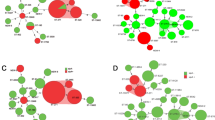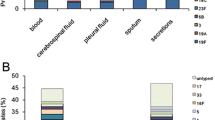Abstract
The purpose of this study was to determine the serotypes, genotypes and antimicrobial susceptibilities of Streptococcus pneumoniae causing otitis media (OM) in children in Dublin, Ireland. S. pneumoniae isolates (n = 28) from spontaneously discharging OM were studied. Serotyping was performed using a previously undescribed multiplex polymerase chain reaction (PCR) scheme in combination with serological methods. Multilocus sequence typing (MLST) was performed using standard procedures. Antimicrobial susceptibility testing was performed using the Etest method. Fourteen different S. pneumoniae serotypes were identified. The five most common serotypes were 3, 19F, 19A, 14 and 6A, which accounted for 68% of all infections. The 7-valent pneumococcal conjugate vaccine (PCV7), 10-valent pneumococcal conjugate vaccine (PHiD-CV) and 13-valent pneumococcal conjugate vaccine (PCV13) provided potential coverages of 43%, 46% and 86%, respectively. Reduced susceptibility to penicillin was evident for 25% of isolates and was associated with serotypes 14, 19A, 19F and 9V. A total of 21 different sequence types (STs) were identified. Pneumococcal Molecular Epidemiology Network (PMEN) clones or their variants represented 54% (15/28) of all isolates. Continued monitoring and characterisation of S. pneumoniae causing OM in Ireland is warranted in order to guide future vaccine and treatment policies.

Similar content being viewed by others
References
Abdelnour A, Soley C, Guevara S, Porat N, Dagan R, Arguedas A (2009) Streptococcus pneumoniae serotype 3 among Costa Rican children with otitis media: clinical, epidemiological characteristics and antimicrobial resistance patterns. BMC Pediatr 9:52
Zhou F, Shefer A, Kong Y, Nuorti JP (2008) Trends in acute otitis media-related health care utilization by privately insured young children in the United States, 1997–2004. Pediatrics 121:253–260
Fletcher MA, Fritzell B (2007) Brief review of the clinical effectiveness of PREVENAR against otitis media. Vaccine 25:2507–2512
O’Halloran DM, Cafferkey MT (2005) Multiplex PCR for identification of seven Streptococcus pneumoniae serotypes targeted by a 7-valent conjugate vaccine. J Clin Microbiol 43:3487–3490
Bennett D, Lennon B, Humphreys H, Cafferkey M (2003) Penicillin susceptibility and epidemiological typing of invasive pneumococcal isolates in the Republic of Ireland. J Clin Microbiol 41:3641–3648
Llull D, López R, García E (2006) Characteristic signatures of the lytA gene provide a basis for rapid and reliable diagnosis of Streptococcus pneumoniae infections. J Clin Microbiol 44:1250–1256
Obregón V, García P, García E, Fenoll A, López R, García JL (2002) Molecular peculiarities of the lytA gene isolated from clinical pneumococcal strains that are bile insoluble. J Clin Microbiol 40:2545–2554
Whatmore AM, Efstratiou A, Pickerill AP, Broughton K, Woodard G, Sturgeon D et al (2000) Genetic relationships between clinical isolates of Streptococcus pneumoniae, Streptococcus oralis, and Streptococcus mitis: characterization of “Atypical” pneumococci and organisms allied to S. mitis harboring S. pneumoniae virulence factor-encoding genes. Infect Immun 68:1374–1382
Brito DA, Ramirez M, de Lencastre H (2003) Serotyping Streptococcus pneumoniae by multiplex PCR. J Clin Microbiol 41:2378–2384
Lawrence ER, Griffiths DB, Martin SA, George RC, Hall LM (2003) Evaluation of semiautomated multiplex PCR assay for determination of Streptococcus pneumoniae serotypes and serogroups. J Clin Microbiol 41:601–607
Pai R, Gertz RE, Beall B (2006) Sequential multiplex PCR approach for determining capsular serotypes of Streptococcus pneumoniae isolates. J Clin Microbiol 44:124–131
Smart LE, Dougall AJ, Girdwood RW (1989) Pneumococcal serotyping. J Infect 18:296–298
Enright MC, Spratt BG (1998) A multilocus sequence typing scheme for Streptococcus pneumoniae: identification of clones associated with serious invasive disease. Microbiology 144:3049–3060
Clinical and Laboratory Standards Institute (CLSI) (2008) Performance standards for antimicrobial susceptibility testing; eighteenth informational supplement. M100-S18. CLSI, Wayne, PA
Yu J, Carvalho Mda G, Beall B, Nahm MH (2008) A rapid pneumococcal serotyping system based on monoclonal antibodies and PCR. J Med Microbiol 57:171–178
Park IH, Pritchard DG, Cartee R, Brandao A, Brandileone MC, Nahm MH (2007) Discovery of a new capsular serotype (6C) within serogroup 6 of Streptococcus pneumoniae. J Clin Microbiol 45:1225–1233
Dagan R, Sikuler-Cohen M, Zamir O, Janco J, Givon-Lavi N, Fraser D (2001) Effect of a conjugate pneumococcal vaccine on the occurrence of respiratory infections and antibiotic use in day-care center attendees. Pediatr Infect Dis J 20:951–958
del Castillo F, Baquero-Artigao F, García-Perea A (1998) Influence of recent antibiotic therapy on antimicrobial resistance of Streptococcus pneumoniae in children with acute otitis media in Spain. Pediatr Infect Dis J 17:94–97
de Neeling AJ, Overbeek BP, Horrevorts AM, Ligtvoet EE, Goettsch WG (2001) Antibiotic use and resistance of Streptococcus pneumoniae in The Netherlands during the period 1994–1999. J Antimicrob Chemother 48:441–444
Goossens H, Ferech M, Vander Stichele R, Elseviers M; ESAC Project Group (2005) Outpatient antibiotic use in Europe and association with resistance: a cross-national database study. Lancet 365:579–587
Rodgers GL, Arguedas A, Cohen R, Dagan R (2009) Global serotype distribution among Streptococcus pneumoniae isolates causing otitis media in children: potential implications for pneumococcal conjugate vaccines. Vaccine 27:3802–3810
Porat N, Soley C, Marengolciene MM, Greenberg D, Givon-Lavi N, Trefler R et al (2008) An international serotype 3 clone causing pediatric noninvasive infections in Israel, Costa Rica, and Lithuania. Pediatr Infect Dis J 27:709–712
Poolman J, Kriz P, Feron C, Di-Paolo E, Henckaerts I, Miseur A et al (2009) Pneumococcal serotype 3 otitis media, limited effect of polysaccharide conjugate immunisation and strain characteristics. Vaccine 27:3213–3222
Pichichero ME, Casey JR (2007) Emergence of a multiresistant serotype 19A pneumococcal strain not included in the 7-valent conjugate vaccine as an otopathogen in children. JAMA 298:1772–1778
Cohen R, Levy C, Bonnet E, Grondin S, Desvignes V, Lecuyer A et al (2010) Dynamic of pneumococcal nasopharyngeal carriage in children with acute otitis media following PCV7 introduction in France. Vaccine 28:6114–6121. doi:10.1016/j.vaccine.2009.05.037
Fenoll A, Martín Bourgon C, Muñóz R, Vicioso D, Casal J (1991) Serotype distribution and antimicrobial resistance of Streptococcus pneumoniae isolates causing systemic infections in Spain, 1979–1989. Rev Infect Dis 13:56–60
Lefèvre JC, Bertrand MA, Faucon G (1995) Molecular analysis by pulsed-field gel electrophoresis of penicillin-resistant Streptococcus pneumoniae from Toulouse, France. Eur J Clin Microbiol Infect Dis 14:491–497
Reinert RR, van der Linden M, Seegmüller I, Al-Lahham A, Siedler A, Weissmann B et al (2007) Molecular epidemiology of penicillin-non-susceptible Streptococcus pneumoniae isolates from children with invasive pneumococcal disease in Germany. Clin Microbiol Infect 13:363–368
Lambertsen L, Brendstrup M, Friis H, Christensen JJ (2010) Molecular characterization of invasive penicillin non-susceptible Streptococcus pneumoniae from Denmark, 2001 to 2005. Scand J Infect Dis 42:333–340
Hermans PW, Sluijter M, Elzenaar K, van Veen A, Schonkeren JJ, Nooren FM et al (1997) Penicillin-resistant Streptococcus pneumoniae in the Netherlands: results of a 1-year molecular epidemiologic survey. J Infect Dis 175:1413–1422
Porat N, Amit U, Givon-Lavi N, Leibovitz E, Dagan R (2010) Increasing importance of multidrug-resistant serotype 6A Streptococcus pneumoniae clones in acute otitis media in southern Israel. Pediatr Infect Dis J 29:126–130
Carvalho Mda G, Pimenta FC, Gertz RE Jr, Joshi HH, Trujillo AA, Keys LE et al (2009) PCR-based quantitation and clonal diversity of the current prevalent invasive serogroup 6 pneumococcal serotype, 6C, in the United States in 1999 and 2006 to 2007. J Clin Microbiol 47:554–559
Acknowledgements
We are grateful to the staff of the Children’s University Hospital, Temple St., Dublin, for their assistance with the collection of the isolates used in this study. We also wish to thank the Health Protection Surveillance Centre, which financially supports the laboratory surveillance of pneumococcal disease in Ireland. We acknowledge the use of the pneumococcal MLST database, which is located at Imperial College London and funded by the Wellcome Trust.
Author information
Authors and Affiliations
Corresponding author
Rights and permissions
About this article
Cite this article
Vickers, I., O’Flanagan, D., Cafferkey, M. et al. Multiplex PCR to determine Streptococcus pneumoniae serotypes causing otitis media in the Republic of Ireland with further characterisation of antimicrobial susceptibilities and genotypes. Eur J Clin Microbiol Infect Dis 30, 447–453 (2011). https://doi.org/10.1007/s10096-010-1108-7
Received:
Accepted:
Published:
Issue Date:
DOI: https://doi.org/10.1007/s10096-010-1108-7




